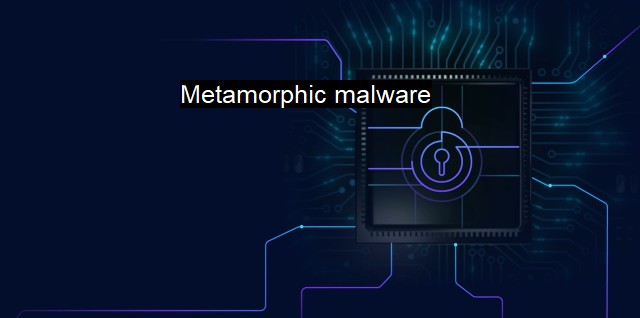What is Metamorphic malware?
Metamorphic Malware: Evading Detection and Posing a Significant Cyber Threat
Metamorphic malware is one of the most sophisticated forms of malicious software that pose significant challenges in the area of cybersecurity. It's not exclusively a product of the 21st century, which is decidedly the malware age, but it is nevertheless difficult to tackle due to its dynamic and changeable nature. Being able to dramatically alter its own code without changing its original functionality or behavior, metamorphic malware can wreak havoc within systems while bypassing even the most robust antivirus software.As a threat, metamorphic malware is highly insidious, showing a significant level of resilience in the face of existing anti-malware technologies, traditional washing procedures, and metabolism instructions. By changing its code at each propagation instance, it develops a new identity that makes it invisible and unrecognizable to antivirus software that relies on signature-based detection. This essentially makes it seem like a new malware entity each time it spreads within a system yielding complete immunity against signature-based antivirus software.
Metamorphic malware employs certain transformation techniques as part of its mutation process including code permutation, register renaming, and instruction substitution among others, allowing it to dodge detection by acquiring complex and nebulous code structures which are difficult to analyse and therefore counter.
The mechanism behind a metamorphic malware’s unique feature lies in its metamorphic engine – a self-adapting algorithm that initiates mutation in the algorithm’s own code without altering the original purpose or functionality. This overpowering adaptability-induced invisibility can be likened to that of a chameleon aiding it in blending perfectly into the environment, making detection a major challenge.
Understandably, combatting metamorphic malware entails complex and deep-level analysis. This is where heuristics come into play, which involves analyzing the behavior or tendencies of a code, sans relying on fixed malware signatures. By exhibiting different patterns in each generation, the AI then applies the discerned rule set or trend to predict and block probable security breaches.
While heuristic detection is seen as a potential defender against metamorphic malware, it too runs the risk of yielding false positives because not all similar behaviors imply malignancy. This area of contention has been the focus of ongoing research towards refining and developing advanced detection solutions beyond the grasp of metamorphic malware capabilities.
Ideally, prevention-oriented approaches are deemed effective in many cases. This includes best cybersecurity practices like keeping all systems and software updated, limiting user account privileges, regularly training employees about malware threats, and maintaining back-ups for quick recovery in case of infections.
Antivirus programs should still be a frontline defense against metamorphic malware despite its insufficiency in detecting it. This is because antivirus software help combat less advanced malware types thereby narrowing down potential threats.
While it is crucial to also address the importance of a robust cybersecurity posture to defend against sophisticated algorithms like these, it does not dilute the requirement for technical countermeasures. Practicing vigilance, maintaining awareness of potential threats, and keeping abreast with latest trends in cybersecurity best practices are all instrumental in preventing metamorphic malware attacks from gaining ground.
Metamorphic malware represents a significant threat in the dynamic landscape of cybersecurity due to its unique ability to self-mutate. Its unprecedented complexity places it on the forefront of advanced, elusive cyber threats facing us today, necessitating the development and implementation of enhanced detection methods and proactive cybersecurity measures. Understanding the functioning of such malware is vital in establishing the next-gen defense and to stay one step ahead in this ongoing cyber warfare.

Metamorphic malware FAQs
What is metamorphic malware?
Metamorphic malware is a type of malware that changes its code and structure with every iteration to evade detection by antivirus software. It is designed to be polymorphic, meaning that it can modify its own code and behavior in several ways. This makes it difficult for traditional antivirus solutions to detect and stop.How does metamorphic malware work?
Metamorphic malware works by constantly changing its code and behavior, making it difficult for antivirus software to detect it. It uses different techniques such as encryption, obfuscation, and mutation to change its code and structure with every iteration. By doing so, it can evade detection and analysis by security researchers and antivirus software.What are the consequences of a metamorphic malware attack?
A metamorphic malware attack can have severe consequences for businesses and individuals. It can steal sensitive data, disrupt critical operations, and damage the reputation of the organization. It can also infect other systems and devices connected to the network, spreading the infection and causing more damage.How can organizations protect themselves against metamorphic malware?
Organizations can protect themselves against metamorphic malware by using advanced antivirus solutions that are capable of detecting and stopping polymorphic malware. They should also implement best practices for cybersecurity, such as regularly updating their software, using strong passwords, and providing security awareness training to their employees. Additionally, they should have a robust incident response plan in place to mitigate the impact of an attack.| | A | | | B | | | C | | | D | | | E | | | F | | | G | | | H | | | I | | | J | | | K | | | L | | | M | |
| | N | | | O | | | P | | | Q | | | R | | | S | | | T | | | U | | | V | | | W | | | X | | | Y | | | Z | |
| | 1 | | | 2 | | | 3 | | | 4 | | | 7 | | | 8 | | |||||||